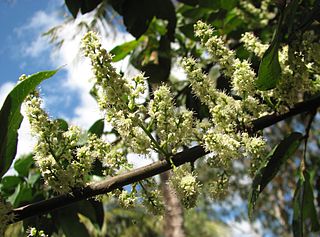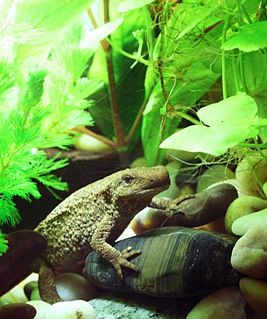
The International Union for Conservation of Nature (IUCN) Red List of Threatened Species, founded in 1964, is the world's most comprehensive inventory of the global conservation status of biological species. It uses a set of criteria to evaluate the extinction risk of thousands of species and subspecies. These criteria are relevant to all species and all regions of the world. With its strong scientific base, the IUCN Red List is recognized as the most authoritative guide to the status of biological diversity. A series of Regional Red Lists are produced by countries or organizations, which assess the risk of extinction to species within a political management unit.

Guioa is a genus of about 78 rainforest tree species known to science, which constitute part of the plant family Sapindaceae. They have a wide distribution, ranging from throughout Malesia, in Burma, Cambodia, Vietnam, Thailand, Malay Peninsula, Borneo, Sumatra, Philippines, Java, Flores, Timor, Sulawesi, Moluccas, New Guinea, further southwards through the east coast of Queensland and New South Wales, Australia and further eastwards to the Pacific Islands, including Tonga, New Caledonia, Fiji and Samoa.
The long-tailed birch mouse is a species of jumping mouse found in Northeast Asia. It has been reported from the Ussuri region of Manchuria, Sakhalin Island and Primorsky Krai in Russia, and northern North Korea. It is listed as data deficient by the IUCN.

The Chinese warty newt is a species of salamander in the family Salamandridae. It is found only in China, with a range extending from Chongqing to Hunan, Anhui, Zhejiang, Fujian, Guangdong, and Guangxi Provinces in Central China. Its natural habitats are subtropical or tropical moist lowland forests, rivers, and freshwater marshes. It is threatened by habitat loss. Female Chinese warty newts reach total length of 151 mm (5.9 in), males are slightly shorter.
Inga caudata is a species of plant in the family Fabaceae. It is found only in Brazil.
Senna domingensis is a flowering plant species in the legume family (Fabaceae). It is a threatened species, found in Cuba, the Dominican Republic, and Haiti.
Senna scandens is a species of flowering plant in the legume family, Fabaceae. It is endemic to Ecuador. There are five known populations. It grows in wet forest habitat in the western Andes.
Senna socotrana is a species of flowering plant in the family Fabaceae, that is endemic to Yemen.
Senna trolliiflora is a flowering plant species in the legume family (Fabaceae). It is a near-threatened species found only in Ecuador. Its natural habitat is subtropical or tropical moist lowland forests.
The Hakuba salamander or Japanese mountain salamander is a species of salamander in the family Hynobiidae. This salamander is also synonymous with the mountain salamander. It is endemic to Japan. Its natural habitats are temperate forests, rivers, swamps, freshwater springs, and plantations. It is threatened by habitat loss.
Clidemia caudata is a species of plant in the family Melastomataceae. It is endemic to Ecuador. Its natural habitats are subtropical or tropical moist lowland forests and subtropical or tropical high-altitude shrubland.
Eugenia caudata is a species of plant in the family Myrtaceae. It is a tree endemic to Peninsular Malaysia. It is threatened by habitat loss.
Graffenrieda caudata is a species of plant in the family Melastomataceae. It is endemic to Guyana.
Micropholis caudata is a species of plant in the family Sapotaceae.
Mitrephora caudata is a species of flowering plant in the family Annonaceae. It is endemic to the Philippines.
Helicia albiflora is a species of plant in the family Proteaceae. It is endemic to Papua New Guinea. It is threatened by habitat loss.
Helicia amplifolia is a species of plant in the family Proteaceae. It is endemic to Papua New Guinea. It is threatened by habitat loss.
Helicia insularis is a species of plant in the family Proteaceae. It is endemic to Papua New Guinea. It is threatened by habitat loss.
Helicia neglecta is a species of plant in the family Proteaceae. It is endemic to Papua New Guinea. It is threatened by habitat loss.
Stenocarpus villosus is a species of plant in the family Proteaceae. It is endemic to New Caledonia. It is threatened by habitat loss.




